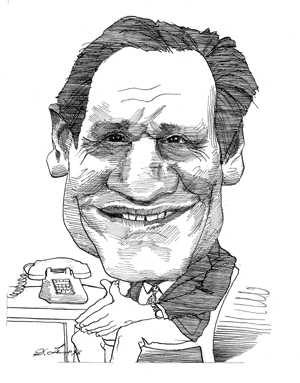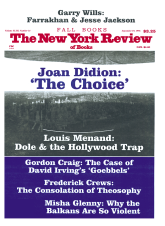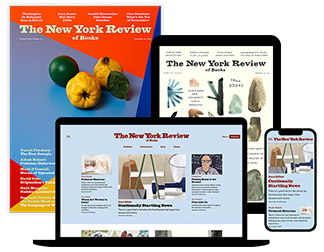On the morning of Sunday, June 23, the day the prepublication embargo on Bob Woodward’s The Choice was lifted, The Washington Post, the newspaper for which Mr. Woodward has so famously been, since 1971, first a reporter and now an editor, published on the front page of its A section two stories detailing what its editors believed most newsworthy in The Choice. In columns one through four, directly under the banner and carrying the legend The Choice—Inside the Clinton and Dole Campaigns, there appeared passages from the book itself, edited into a narrative describing the meetings Hillary Clinton had from 1994 to 1996 with Jean Houston, who was characterized in the Post as “a believer in spirits, mythic and other connections to history and other worlds” and as “the most dramatic” of Mrs. Clinton’s “10 to 11 confidants,” a group that includes her mother.
This account of Mrs. Clinton’s not entirely remarkable and in any case private conversations with Jean Houston appeared under the apparently accurate if unarresting headline “At a Difficult Time, First Lady Reaches Out, Looks Within,” occupied one-hundred-and-fifty-four column inches, was followed by a six-column-inch box explaining the rules under which Mr. Woodward conducted his interviews, and included among similar revelations the news that, according to an unidentified source (Mr. Woodward tells us that some of his interviews were on the record, others “conducted under journalistic ground rules of ‘background’ or ‘deep background,’ meaning the information could be used but the sources of the information would not be identified”), Mrs. Clinton had at an unspecified point in 1995 disclosed to Jean Houston (“Dialogue and quotations come from at least one participant, from memos or from contemporaneous notes or diaries of a participant in the discussion”) that “she was sure that good habits were the key to survival.”
The remaining front-page columns above the fold in that Sunday morning’s Post were given over to a news story based on Mr. Woodward’s The Choice, written by Dan Balz, running seventy-nine column inches, and headlined “Dole Seeks ‘a 10’ Among List of 15: Running Mate Must Not Anger Right, Book Says.” Mr. Woodward, according to this story, “quotes Dole as saying he wants a running mate who will be ‘a 10’ in the eyes of the public, with the candidate telling the head of his search team, Robert F. Ellsworth, ‘Don’t give me someone who would send up [anger] the conservatives.”‘ Those Post readers sufficiently surprised by this disclosure to continue reading learned that “at the top of the list of 15 names, assembled in the late spring by Ellsworth and Dole’s campaign manager, Scott Reed, was Colin L. Powell.” When I read this in the Post I assumed that I would find some discussion of how or whether the vice-presidential search team had managed to construe their number-one choice of Colin L. Powell as consistent with the mandate “Don’t give me someone who would send up the conservatives,” but there was no such discussion to be found, neither in the Post nor in The Choice itself.
Mr. Woodward’s rather eerie aversion to engaging the ramifications of what people say to him has been generally understood as an admirable quality, at best a mandarin modesty, at worst a kind of executive big-picture focus, the entirely justifiable oversight of someone with a more important game to play. Yet what we see in The Choice is something more than a matter of an occasional inconsistency left unexplored in the rush of the breaking story, a stray ball or two left unfielded in the heat of the opportunity, as Mr. Woodward describes his role, “to sit with many of the candidates and key players and ask about the questions of the day as the campaign unfolded.” What seems most remarkable in this new Woodward book is exactly what seemed remarkable in the previous Woodward books, each of which was presented as the insiders’ inside story and each of which went on to become a number-one bestseller: these are books in which measurable cerebral activity is virtually absent.
This Issue
September 19, 1996
-
*
The Washington Post: “Origin of the Tax Pledge,” by Bob Woodward (October 4, 1992, p. A1), “No-Tax Vow Scuttled Anti-Deficit Mission,” by Bob Woodward (October 5, 1992, p. A1), “Primary Heat Turned Deal into a ‘Mistake,”‘ by Bob Woodward (October 6, 1992, p. A1), and “The President’s Key Men: Splintered Trio, Splintered Policy,” by Bob Woodward (October 7, 1992, p. A1).
↩






